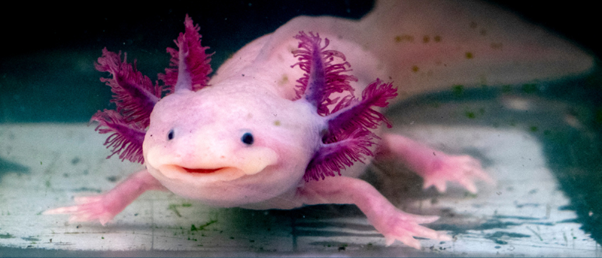
BioTechniques News
Beatrice Bowlby

Researchers find that senescent cells promote the dedifferentiation of muscle tissue and enhance limb regeneration in salamanders, challenging our understanding of cellular senescence.
Senescent cells are associated with the detrimental physiological effects that accompany aging. However, researchers at the Dresden University of Technology (Germany) have been studying salamander limb regeneration and found that cellular senescence occurs naturally throughout this process and actually enhances regeneration.
The accumulation of senescent cells, cells that have permanently stopped dividing due to cellular stress, is considered one of the hallmarks of aging and has been linked to cancer, Alzheimer’s and osteoarthritis, among other diseases.
This research group, led by Maximina Yun, has previously found that senescent cells are present in key stages of salamander limb regeneration. “We, therefore, wanted to find out whether these cells contribute in any way to regeneration itself,” commented Yun.
Salamanders have a unique ability to regenerate and regrow many organs in their body, including fully functional limbs in a matter of weeks. Alongside their impressive healing abilities, salamanders do not accumulate age-related diseases like cancer.
 Love really hurts without you: oxytocin helps regenerate the heart
Love really hurts without you: oxytocin helps regenerate the heart
Oxytocin, the neurohormone responsible for pleasure, has been found to help regenerate cardiomyocytes in zebrafish and human stem cell cultures.
The researchers changed the number of senescent cells present in a wound and used transcriptomic profiling and loss of function approaches to study the effect. They found that implanted senescent cells promoted the dedifferentiation of mature muscle tissue into regenerative progenitors and increased the number of regenerating muscle cells.
The researchers reported that when more senescent cells were present in the wound, the salamanders developed a larger blastema, which is a collection of cells that form all the needed tissue in the new limb. A larger blastema speeds up the regeneration process as this increases the number of cells present to regrow the limb.
By studying the blastema with and without senescent cells in more detail, they found that senescent cells secrete factors that stimulate nearby muscle tissue to produce more muscle.
“Our results show that senescent cells use cell-cell communication to influence the regeneration process. They secrete molecules that signal to mature muscle fibers to dedifferentiate into muscle progenitor cells. These cells can multiply themselves as well as differentiate into new muscle cells, thereby enhancing the regeneration process,” explained Yun.
In this study, the researchers focused on muscle tissue, which is one of the most important tissues for limb regeneration. They hope to investigate whether senescent signaling also contributes to regeneration in other tissues.
The post Senescent cells enhance limb regeneration appeared first on BioTechniques.
Full BioTechniques Article here
Powered by WPeMatico
